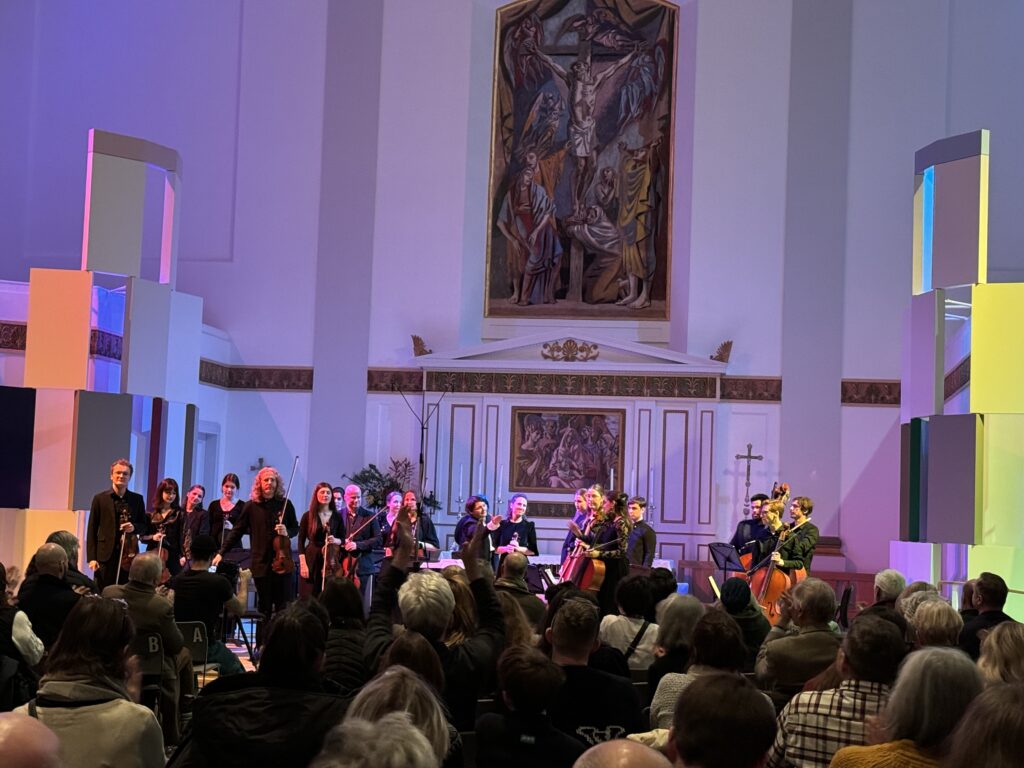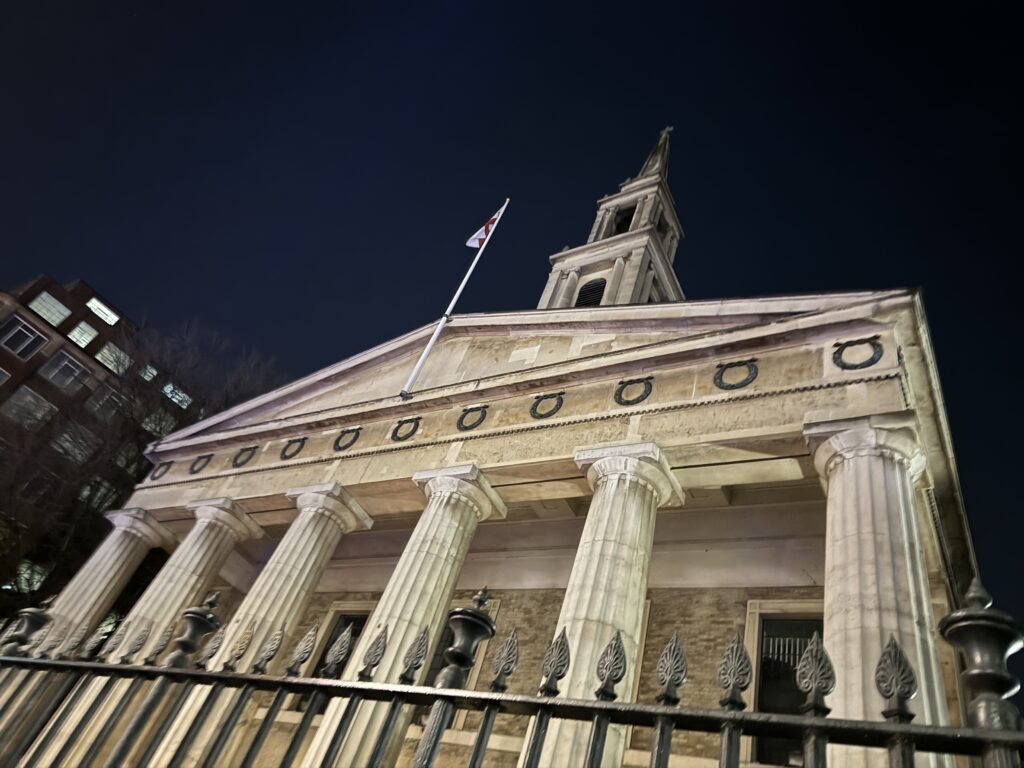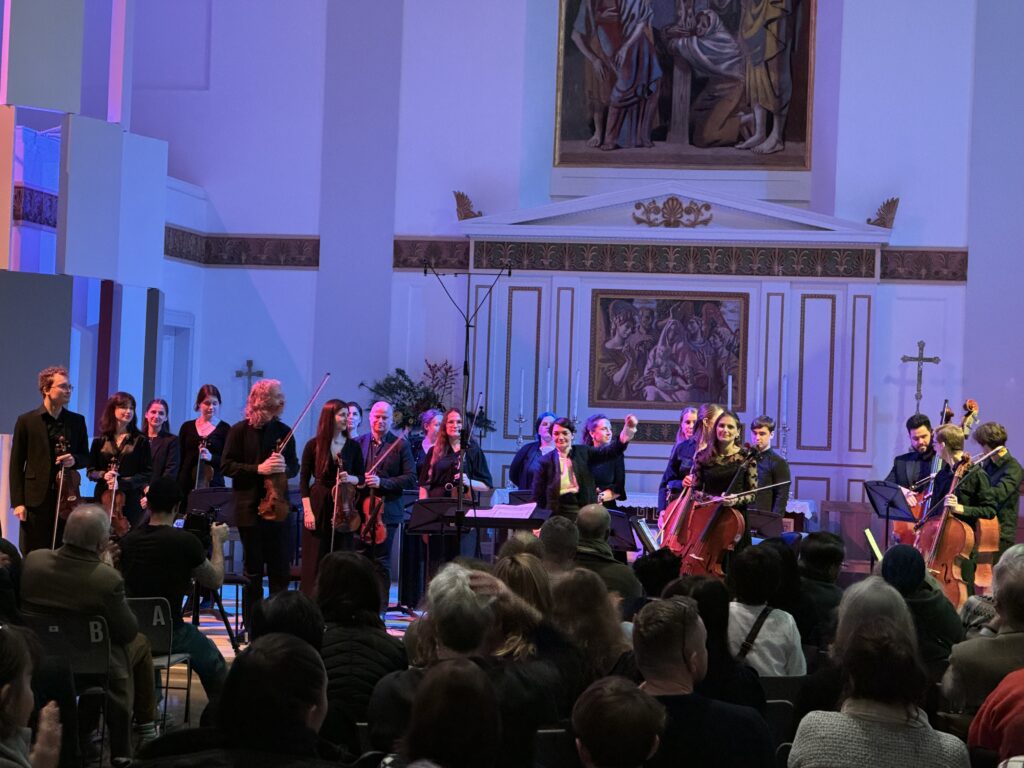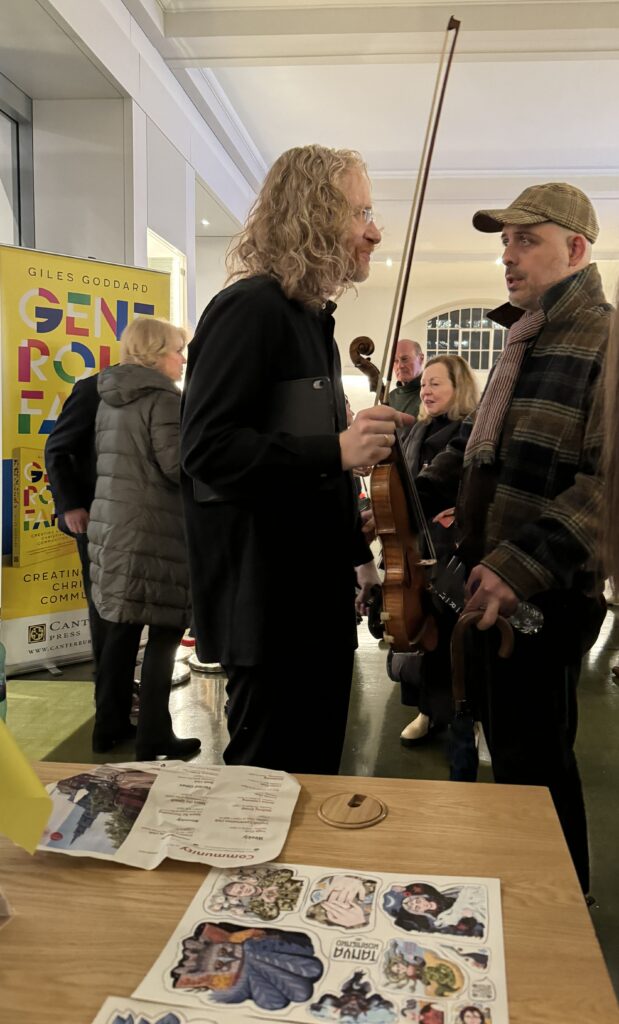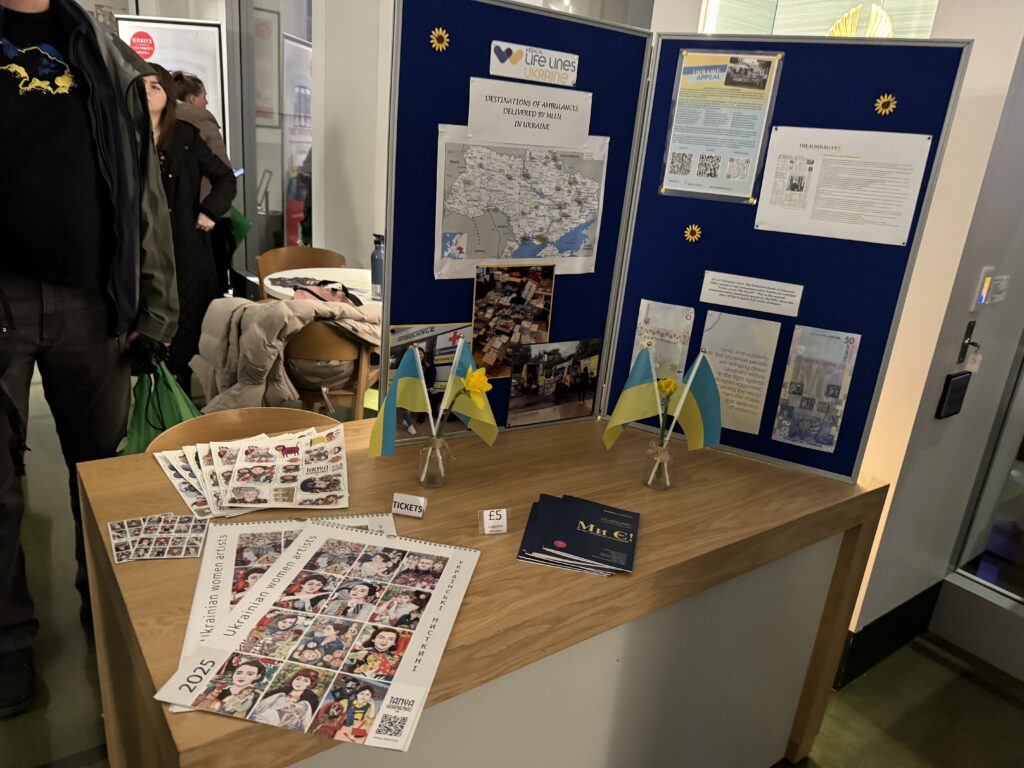WE ARE! CONCERT IN SUPPORT OF UKRAINE — London, 26.1.2025 (original) (raw)
26 січня 2025 року у лондонській церкві St John’s Church, Waterloo відбувся організований Романом Мінцем концерт «Мі Є!» Розповісти про цей концерт можна багато, але про те, що стосується музичної частини, вже є експертна думка. Ось що написала про подію у фб и для improvisator.com.ua заслужений діяч мистецтв України Леся Олійник 1 2 (додані посилання на сторінки, де ви знайдете більше інформації про кожного зі згадуваних великих музикантів та композиторів)
St. John’s Waterloo
«Саме з цієї жалобної народної мелодії «Пливе кача» розпочався концерт української музики, що відбувся в церкві St. John’s Waterloo, розпочався зі скорботного реквієму за розстріляними під час Майдану 1914, що став наче провісником початку жорстокої війни.
Жоден з епітетів не зможе передати силу емоційного впливу, що його несла музика — напружений драматизм Concerto grosso Віталія Губаренка, космічну красу «Мессенджера» Валентина Сильвестрова, нестримну енергетику «Карпатської рапсодії» Мирослава Скорика, різкі злами музики ніжності та тривоги третьої камерної симфонії Євгена Станковича, сповільнений «рух у безодню» «Білого поховання» Вікторії Польової та завершальне ствердження «Ми Є!» — ліричний парафраз Юрія Шевченка на мелодію державного символу України.
Абсолютно органічно «доповнили» українську партитуру «Варіації на українську тему» класика англійської музики ХХ ст. Малколма Арнольда, а його ж Концерт для двох скрипок та струнного оркестру лише посилив експресивну палітру музичних образів.
Важко було повірити, що всі ці надскладні твори виконували зовсім молоді музиканти — студенти лондонських музичних закладів (майже всі вони українці), що є артистами струнного оркестру Another Chamber Orchestra, художнім керівником якого є супер-професіонал, скрипаль Роман Мінтц, а також феноменальні солісти — український піаніст Саша Гринюк, харківський скрипаль Дмитро Удовиченко, той же Роман Мінтц, відомий англійський гобоїст Ніколас Даніел та народжений в Гон Конзі Карен Вонг (як же він точно «уловив» флейтову інтонацію Станковича!).
Але героїнею концерту, звісно, була знакова українська диригентка Наталя Пономарчук. Саме вона давала дихання кожному твору, саме від Маестро Пономарчук йшов той високий музичний струмінь, що буквально наелектризував простір старовинного храму. Саме вона «будувала» «на очах» складні образні конструкції, давала життя композиторським задумам, слідкуючи за драматургією кожного твору, за ідеальним ансамблем соліста й оркестра, вибудовуючи яскраву панораму сучасної української музики!
Після концерту можна було почути захопливі слова «Боже, яка музика!», а водночас, подив: «Чому раніше ми не чули?», «Чому ваша музика не звучить скрізь і постійно?»
Власне, для цього й був цей концерт, організатором й автором ідеї якого є вже згадуваний Роман Мінтц.
Цей концерт став також потужним донатом для медичної допомоги Україні.»
Диригент — Наталя Пономарчук
На першому плані стікер із генералом Валерієм Залужним, який зараз працює послом у Великій Британії. І за ним Роман Мінц та Рома Ліберов.
Організатор концерту, Роман Мінц «професор скрипки у Trinity Laban Conservatoire of Music and Dance и Royal Birmingham Conservatoire, створював різноманітні концертні програми вже понад чверть століття. Після початку повномасштабного вторгнення він брав участь у кількох кампаніях зі збору коштів для благодійних організацій, які допомагають Україні. Він заснував Another Music Festival Ltd, щоб просувати концерти, об’єднувати молодих і досвідчених музикантів і створювати музичні програми з несподіваними поворотами». 1 Ось що Роман пише у групi Medical Life Lines Ukraine 1, чому організував концерт: «I created this project with multiple goals: to introduce the culture that some people do not want to acknowledge (we are doing two UK premieres), to help young Ukrainian musicians who have found themselves in the UK during the war, and to connect them with UK musicians and provide useful contacts. I also want to let the Ukrainian people know that they are not forgotten by those in the UK, and **to raise money for ambulances and power generators.**» Тобто щоб підвищити видимість української музики, допомогти молодим українським музикантам утвердитись у професійному світі, а також зібрати гроші для покупок машин швидкої допомоги та генераторів.
Організацію, яка отримала зібрані на концерті гроші, Medical Life Lines Ukraine, створила лондонський адвокат Алія Аралбаєва. Допомога, яку від початку вторгнення Алія відправила до України, обчислюється у сотнях тисяч фунтів: «Since 25 February 2022 built SW19 supporters’ network which raised and sent to Ukraine humanitarian aid for over £500K. Started a crowdfunding and a movement in South-West London that raised over £120K. Sent and donated 16 ambulances to Ukraine hospitals in rural areas where help needed the most. Organised number of humanitarian aid deliveries to Ukraine, including a food truck to Slavutych, city near Chernobyl nuclear plant, within days of it getting out of occupation by the Russian forces.»
Я взяла з собою до Лондона кілька календарів, стікерів та магнітів київської художниці Тані Корнієнко Tanya Kornienko Art, щоб люди могли купити їх та ще більше збільшити пожертвування на українську медицину. Майже всі люди, які потім взяли щось із речей і пішли зробити донат, питали про українських художниць, розповідали про свою небайдужу позицію, про свою роботу на допомогу Україні з початку війни. Так я зрозуміла, що і серед глядачів немає випадкових людей, що багато хто сприймає концерт значно масштабніше навіть за історично музичну подію (у тому сенсі, що ця подія історична для розвитку української музики). Як ще один бій, як бій на культурному фронті.
Вражає, що коли багато українців під час війни включають дурня, нічого не роблять, живуть на своє задоволення, хоча від них чекають максимальних зусиль для порятунку України (тобто коли вони абсолютно повинні це робити), люди, які дуже давно живуть у Великобританії, прикладають стільки сил, часу, грошей для порятунку України, хоча могли б включити дурня, нічого не робити, жити на своє задоволення (тобто коли вони взагалі не повинні це робити). У порівнянні з норвежцями англійці відчувають набагато більше відповідальності за те, що відбувається — з різних причин, в які я тут не вдаватимуся.
Також дивує кількість британських культурних та політичних заходів, присвячених Україні. На третій рік війни — коли б ви не приїхали до Лондона, за бажання ви знайдете, як доторкнутися до життя місцевої діаспори. Все анонсується у групах у телеграми. За тиждень відбувається 2-3 вражаючі події високого професійного рівня. Кінопокази, дискусії, благодійні вечори, концерти, фестивалі, виставки, ярмарки… І організують їх не лише люди, пов’язані з посольством чи офіційними організаціями. Помітно, що кожен, хто може, діє.
На концерті працювали три волонтери — вони ходили з кубами для донатів, продавали диски, гуртки, програми. Це було добре організовано та допомагало збільшити збір.
Триває війна, вмирають люди, руйнується історична та культурна спадщина. I водночас завдяки великим зусиллям людей, які ненавидять диктатуру, звучить всепереможна українська музика. Їдуть до кордону споряджені ліками машини швидкої допомоги. Їдуть конвої гуманітарної допомоги та зброї. Чим більше долонь волонтерів прикладено до ран, тим більше ми маємо можливості врятувати і зберегти вільну Україну та українську культуру. Ми є.
Upd 8.2.2025
Mи Є! Concert in Aid of Ukraine
by Guy Rickards | Jan 28, 2025

Roman Mints, far left, with members of Another Chamber Orchestra, © Guy Rickards
Nicholas Daniel (ob), Sasha Grynyuk (pf), Roman Mints (vn), Julia Morneweg (vc), Luba Tunnicliffe (va), Dmytro Udovychenko (vn), Karen Wong (fl), Another Chamber Orchestra / Natalia Ponomarchuk
St John’s Waterloo, London, January 26, 2025
Another Chamber Orchestra? Yes, that really is their name and a rather fine ensemble they are, comprising mostly Ukrainian students (“immensely talented” Ukrainian students to quote their artistic director, Roman Mints) strengthened by a few British performers. The juxtaposition was particularly appropriate for this sold-out charity concert set up to raise funds for Medical Life Lines Ukraine (which provides reconditioned ambulances in good running order, with drivers, for the war-torn nation), as set within the Ukrainian programme for (mostly) string orchestra were two works by Malcolm Arnold.
The concert was topped and tailed by two emotive arrangements or reworkings of pre-existing Ukrainian songs. Viktor Rekalo’s chillingly elegiac Plyve Kacha is based on the wistful folksong ‘Plyve kacha po Tysyni’ (‘A Duckling Swims in the Tisza’) and was created as a memorial to those killed in the Euromaidan protests and Revolution of Dignity (2013-4) and the ensuing war with Russia. The resonances of the Tallis Fantasia in the tutti sections provided a wider harmonic context for the whole. Euromaidan also provoked Yuri Shevchenko (1935-2022) to write his dignified Paraphrase on the Ukrainian National Anthem, Mи Є! (‘We Are!’), which gave the concert its title. A different war gave rise to Arnold’s rather weightier Variations on a Ukrainian Theme (1944), which he composed as a piano piece for John Kuchmy, a violinist colleague of Ukrainian descent at the London Philharmonic Orchestra. In 1993, Roger Steptoe made a virtuosic arrangement which brings out the subtleties of Arnold’s invention all the more. The starkness of the original is lost—some of the jazziness in early variations too—replaced to the work’s advantage by a wider palette of colours to match Arnold’s characteristically broad, if not kaleidoscopic, expressive range. The orchestra audibly relished this tribute to their heritage in playing of real fervour, though perhaps an additional viola or two (there were just three players) might have balanced out the inner part a little, which seemed a little thin, though conductor Natalia Ponomarchuk made as light of this as she could.
There was no problem with viola tone in Vitaliy Hubarenko’s Concerto Grosso, Op 33 (1981), with its concertino for string trio, in this case Roman Mints, Luba Tunnicliffe (whose viola tone was commendable robust) and Julia Morneweg. Although Hubarenko (1934-2000) is one of Ukraine’s finest composers, he is largely unknown beyond its borders, and little is available currently on CD or other formats (the Presto Classical database has nothing), but the Ukrainian Music Channel have made recordings available which are accessible in YouTube. [e.g. https://www.youtube.com/watch?v=ffS6vQnm6Lg] Concerto Grosso, receiving its UK Premiere, is a rather stern succession of three slow-paced movements (‘Sostenuto, mesto’; ‘Andante cantabile’; ‘Adagio tranquillo’) blending, as concert annotator and second violinist Sofi Lomidze commented, “the Baroque concerto grosso form with modern musical elements.” The modern musical elements are largely confined to the melodic angularity and harmonic dissonances, the form itself with its interplay of concertino (with lots of solos and duos between the three players) and ripieno quite recognisable. The work is very well laid out for a string ensemble, and in the finale achieves a true catharsis at the centre, followed by Shostakovich pathos towards the close. Miroslav Skoryk (1938-2020) is better known in the West with several albums widely available on Naxos and other labels. His much-recorded Carpathian Rhapsody, composed for the David Oistrakh Competition in Odesa in 2004, is a real crowd-pleaser. Its almost Nationalist-Romantic idiom has made it a popular item and Dmytro Udovychenko produced a barnstorming performance to close the first half, full of fire, relishing its technical and stylistic challenges, not least the flashes of Bartók and klezmer along the way, enthusiasm shared by the orchestra and Ponomarchuk, who proved herself a real firecracker of a conductor.
Probably the best-known work opened the second half, Valentin Silvestrov’s The Messenger (1996), in the version for piano and a tape (or CD) or wind sounds (an alternative to the prescribed synthesizer) with muted strings. Following the pyrotechnics of the Carpathian Rhapsody, Silvestrov’s ethereal contemplation prompted by the death of his wife made the maximum possible contrast, with its Mozartian resonances, and haunting effects. Sasha Grynyuk was the delicate soloist (though played with the piano lid open, ignoring the composer’s suggestion to keep it closed), joined by Roman Mints for the violin solos that punctuate the piece. Another inspired by a composer’s wife—living, thankfully—then followed, the vibrant single-movement Chamber Symphony No 3 for flute and strings (1982) by Yevhen Stankovych (b1942). An altogether fierier work (see YouTube https://www.youtube.com/watch?v=nPhwpE5yEjU], its many faces (could this be a portrait of the lady?) were projected with jaw-dropping virtuosity by Hong Kong-born flautist Karen Wong, currently a Britten-Pears Young Artist. It is a very impressive piece and Wong’s breath-taking performance of its very busy flute part, with Ponomarchuk’s intensely responsive support, was a highlight of the concert.
Nicholas Daniel then joined the orchestra for the other UK Premiere: Victoria Poleva’s White Interment, which the composer (b1962) describes as a ‘symphony’ scored for oboe and strings. Composed in 2003, the work is again in a single span and based on the poem ‘Teper vsegha snega’ (‘Now always snows’) by the Chuvash writer, Gennady Aygi (1934-2006). Although not an unvoiced setting of the poem, the musical material derives from the rhythms of the poetic text, and its succession of “mirror-symmetric blocks… are graphically defined baroque rhetorical figures” flow into each other seamlessly, designed to produce “psychedelic emotional effects.” An example of Poleva’s later “sacred minimalist” style, I am not convinced entirely of the work’s symphonic credentials. If one accepts Hans Keller’s definition of a symphony as the “large-scale integration of contrasts”, there is a degree of musical integration in White Interment [see YouTube https://www.youtube.com/watch?v=SUuZWJuU1xg for a performance in Kyiv conducted by Ponomarchuk] and an undoubted cumulative impact, (especially in this captivating account from Daniel and the orchestra) but is lighter on contrast. This intense, focused work strikes me as a movement from rather than a whole symphony, but the intensity of the performance convinced the audience.
The final main work, setting to one side Shevchenko’s titular coda, was Arnold’s Concerto for 2 violins and strings, Op 77 (1962), the only work with a tenuous Ukrainian link (it was composed for Menuhin and his Argentinian-born student, Alberto Lysy, whose parents had immigrated from Ukraine). This is to my mind Arnold’s finest concerto (the Second for clarinet, notwithstanding) and drew a performance of power, passion and nuance from Mints and Udovychenko whose mutual understanding on the night was total. Curiously, they opted to stand between the front desk of the second violins and conductor Ponomarchuk rather than to her side or back, but this did not impair the balance or clarity of their playing, whether the climactic closing duet of the central Andantino or the electrifying final Vivace-Presto, the conclusion of which brought the house down. Quite an occasion.
__________________
Here is the album of photos by Anastasia Tikhonova https://www.facebook.com/share/12F8tLiUCDY/
